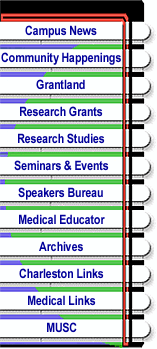
Return to Main Menu |
Simple
test detects hidden heart disease
MUSC will begin offering a simple screening test to predict an individual's
risk of heart attack or other coronary events. The test, known as cardiac
scoring, uses an ultrafast CT Scan to quantify calcium deposits in the
coronary artery.
Coronary artery calcium is one component of plaque and is a marker
for atherosclerosis (hardening of the arteries), explained Michael E. Assey,
M.D., director of the Cardiology Division. “Calcification found in the
coronary artery is an indicator of atherosclerotic plaque in the lumen
of the blood vessel and/or the blood vessel wall,” he said. “In general,
people who don't have coronary calcification are not likely to have blockages
verified by heart catheterization, and those with a lot of calcification
are likely to have at least a single blockage in a major heart artery.”
Autopsy reports and other data have consistently shown correlation between
coronary artery calcium content and the severity of coronary artery disease.
The cardiac scoring test can detect calcium deposits long before they
are large enough to form an obstruction in the blood vessel lumen. The
study of nearly 4,000 patients just published in Circulation, an
official publication of the American Heart Association, compared results
of the SPECT thallium stress test, a frequently used test which requires
the injection of a radioactive substance, with the Cardiac Scoring Test.
When calcium was shown to be severe according to the Cardiac Score,
the SPECT test showed an abnormality only one-half of the time. “The calcium
test is more sensitive,” explained Assey. “It will find plaque in the blood
vessel wall, whereas the thallium stress test detects blockages that have
developed from the plaque and are bulky enough to limit flow through the
artery. Instead of looking at the "hole in the donut," the calcium
score evaluates the donut itself. This makes the test an extremely valuable
screening device to identify the person who has no symptoms, but has significant
plaque in the blood vessel wall. In such a case, it is not unusual
for a small amount of plaque to change shape, attract a clot and result
in a heart attack.
It is important that the test be done along with physician interaction
to determine how to properly use the data, said Assey. There are
situations where a person with a negative result could still be at risk
for a heart attack. For example, an individual who smokes might not be
protected from a heart attack even with a low calcium score. In general,
the physician looks at the results of the scan in conjunction with a variety
of other information to determine the appropriate course of action. The
results might lead to heart catheterization. For many patients, however,
a low calcium score might lead only to a change in diet, exercise or other
medication.
“The value of this screening test lies in its simplicity,” said J.
Bayne Selby Jr., M.D., an MUSC vascular radiologist. “It is one of
the easiest tests in the field of medical imaging that I have seen in the
last 20 years.” The patient, in street clothes, lies on a table that slides
him through a scanning device that looks like a large donut. The scanner
records information into a computer, and the entire process is completed
in about two minutes.
The computer produces a series of cross section images of the heart,
including the coronary arteries. The vascular radiologist examines each
of the images, carefully circling any area where calcification is observed.
The computer calculates the quantity of the calcium present. The radiologist
then uses this number to give the test result a “score.” This score puts
the patient into one of four or five categories of risk, ranging from normal
to extremely high risk. “While data from other centers around the country
have shown a high correlation between the cardiac score and heart disease,
we wanted to validate these findings ourselves before offering the test
at MUSC,” said Assey.
Selby, Assey and Lee Butterfield, M.D., looked at a series of MUSC
patients undergoing heart catheterization for an assortment of reasons.
The vascular radiologists did the cardiac scoring without knowledge
of the results of the cardiac catheterization. When the results were compared,
an excellent correlation was found between the two tests.
This simple screening method is relatively new and is possible because
of the availability of high speed CT scanning equipment. Since the coronary
arteries supply blood to the heart muscle and are in constant motion as
the heart beats, the production of X-ray images of the moving vessels was
not possible until the advent of the high speed equipment. The first Ultrafast
CT used an electron gun with a sweeping motion to collect images. The conventional
scanners need time to rotate mechanically around the patient. This can
result in blurred images because of heart motion. The Ultrafast CT catches
the heart between beats while the patient holds his breath.
Cardiac scoring had its beginnings in the Western United States about
10 years ago when several centers began using electron beam CT equipment
to produce cardiac scoring based on calcification. But using the
electronic beam CT was an extremely expensive procedure. It is only recently
that the conventional CT equipment has become much faster, producing image
quality capable of performing cardiac scoring. MUSC has one of these new
Ultrafast Helical CT scanners and is the first center in South Carolina
to offer this relatively inexpensive test.
To schedule a Cardiac Scoring Test, call 792-1414. |


